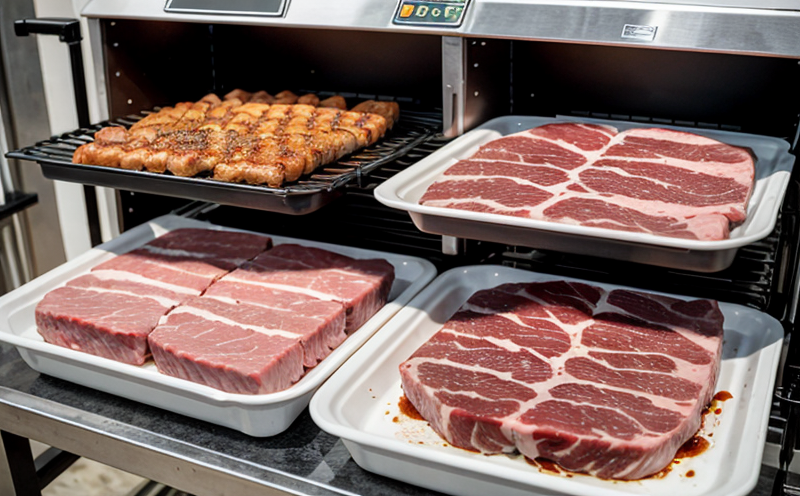ISO 18593 Surface Microbiological Sampling in Meat Processing
The ISO 18593 standard provides a robust framework for conducting surface microbiological sampling, which is critical for ensuring food safety and quality during the processing of meat products. This method aims to accurately quantify microorganisms present on the surfaces of carcasses, cuts, or packaging materials used in the meat industry.
The primary focus of this service involves adhering strictly to ISO 18593 guidelines to collect samples from specified areas on carcasses or packaged meats. The sampling process is designed to minimize contamination and ensure that representative samples are collected for microbiological analysis. This method ensures that any potential contaminants can be detected early, enabling swift corrective actions if necessary.
The standard specifies the use of a specific swabbing technique combined with appropriate preservation methods to maintain sample integrity until analysis. It also details the calculation of surface coverage and how to interpret the results in terms of microbiological load on surfaces. This approach helps meat processors understand their sanitation protocols' effectiveness, ensuring adherence to regulatory requirements.
The application of this method is particularly crucial for monitoring hygiene practices during slaughterhouse operations or in processing facilities where food safety is paramount. By following ISO 18593, quality managers and compliance officers can ensure that all surfaces involved in meat handling meet stringent cleanliness standards set forth by the standard.
Our laboratory employs advanced microbiological testing techniques to analyze samples collected according to this method. Our team of experts uses state-of-the-art equipment to perform quantitative microbial counts (QMC) as per ISO 18593, providing precise data on surface contamination levels. This information is invaluable for identifying problem areas within processing environments and implementing targeted improvements.
Compliance with ISO 18593 not only aids in maintaining high standards of hygiene but also supports the broader goal of protecting public health by ensuring that only safe products reach consumers. By adhering to these internationally recognized standards, meat processors demonstrate their commitment to food safety and quality.
Scope and Methodology
The ISO 18593 standard defines the procedure for sampling surfaces in meat processing facilities. It specifies the type of swabs to be used (typically non-shedding synthetic fibers), the area to be sampled, and the method of collection. The standard also outlines how samples should be preserved before analysis.
The methodology involves selecting representative areas on the carcass or packaging material based on predefined criteria such as high-risk zones for contamination. A standardized swabbing pattern is then followed to ensure consistent sampling across different batches or production runs. After collecting the sample, it must be transported under controlled conditions to prevent microbial growth.
Our laboratory adheres meticulously to these procedures when conducting ISO 18593 compliant surface microbiological sampling. We employ trained personnel using calibrated instruments and follow strict protocols throughout each step of the process—from swabbing to preservation—to guarantee accurate results.
Industry Applications
Table: Common Areas Sampled According to ISO 18593
| Area | Description |
|---|---|
| Carcass surfaces | The outer skin of the carcass, which comes into direct contact with processing equipment. |
| Cutting boards and tables | Work surfaces used during slicing or cutting operations. |
| Packaging materials | Materials used to wrap or package finished products. |
The sampling process described in ISO 18593 has wide-ranging applications across the meat and poultry industries. It is essential for verifying that all surfaces involved in production meet regulatory cleanliness standards set by authorities like the USDA (United States Department of Agriculture) or EU regulations.
- Ensures compliance with international food safety standards
- Aids in identifying potential sources of contamination early
- Supports continuous improvement initiatives aimed at enhancing overall hygiene practices
- Enables traceability of batches based on microbiological data collected during processing
This method helps meat processors maintain strict adherence to industry best practices while ensuring product safety and quality.
International Acceptance and Recognition
The ISO 18593 standard has gained widespread acceptance globally, particularly in regions where food safety regulations are stringent. Many countries have adopted this standard as part of their national guidelines for meat processing facilities. Compliance with ISO 18593 is seen as a benchmark for ensuring the highest levels of hygiene and quality control.
International organizations such as the World Health Organization (WHO) and the Food and Agriculture Organization (FAO) recommend adherence to this standard when addressing food safety issues in developing countries. Similarly, regulatory bodies like the European Commission and the FDA in the United States recognize ISO 18593 as a reliable method for microbiological sampling.
By implementing ISO 18593-compliant practices, meat processors can demonstrate their commitment to global standards of quality and safety. This recognition enhances customer confidence and fosters trust among consumers, distributors, and other stakeholders within the supply chain.





